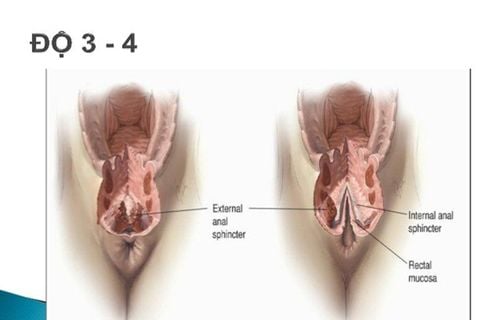This is an automatically translated article.
Prolapse of the umbilical cord (chordal cord) is a first-line emergency because it causes acute fetal distress because the umbilical cord is compressed between the throne and the pelvic wall or because when the umbilical cord prolapses outside the vagina, the blood supply of the umbilical cord For fetal stagnation due to spasm of the umbilical cord blood vessels. If the umbilical cord prolapse is not treated promptly, it can be dangerous for both mother and baby.
1. When does umbilical cord prolapse occur?
Prolapse of the umbilical cord is a common complication that occurs in the late stages of pregnancy (more than 38 weeks gestation). This phenomenon can easily cause acute fetal distress during labor. Therefore, when detecting that a woman has prolapsed umbilical cord, it is necessary to receive immediate emergency care within 30 minutes to save the baby.
There are many causes of umbilical cord prolapse during labor (multiple births); pregnancy (abnormal pregnancy); adnexa (polyhydramnios...); amniocentesis when the throne is still high and loose...
So far, there are no specific measures to prevent prolapse of the umbilical cord. Therefore, the most important thing to avoid this complication, pregnant women need to have regular antenatal check-ups; The doctor can detect risk factors to warn as well as advise on choosing a safe place to give birth (with conditions for caesarean section).

Sa dây rốn là biến chứng thường gặp xảy ra vào giai đoạn cuối của thai kỳ (thai khoảng hơn 38 tuần)
2. General treatment of umbilical cord prolapse
In case of prolapse of the umbilical cord in the amniotic sac:
At commune levels: It is necessary to advise the mother to lie down with her head low, butt high, not to push to protect the water from breaking. Intramuscular papaverine 40-80mg. Then quickly switch to the above route. For district level: Immediate cesarean section. For umbilical cord prolapse when membranes have broken:
For commune level: Determine if the umbilical cord is still beating by clamping the umbilical cord between two fingers to see if the umbilical cord is pulsating strongly or weakly. Simultaneously listen to the fetal heart on the mother's belly. If it is determined that the fetus is dead (the umbilical cord stops beating, the fetal heartbeat is not heard), then there is no longer an emergency (explain to the family and the mother that the fetus no longer has a fetal heart and just let the birth take place normally) without having to undergo emergency surgery). If the fetus is still alive, place the woman on her back and gently push the umbilical cord up. Intramuscular papaverine 40 - 80mg if contractions are rapid. Advise the mother not to push and the possible adverse effects on the fetus. At the same time, quickly transfer to the upper line.
Note, before transferring, if possible, wrap the prolapsed umbilical cord in a large gauze soaked in warm 9‰ isotonic saline, cover the mother with sterile gauze, and then immediately transfer to a higher level. Alternatively, a Foley catheter can be inserted and the bladder is filled with 500ml of 9‰ isotonic serum, clamping the tip of the catheter to prevent the fetal head from descending.
For district level: Determine if the umbilical cord is still beating by clamping the placenta between two fingers and listening to the fetal heart. If the fetus is still alive, it must seek a cesarean section immediately. While waiting for the surgery, the mother should lie down with the head low and the buttocks high so that the support cord is pressed tightly between the throne and the pelvis. If the fetus has died, follow up to make the birth progress normally.
3. What do you need to do when the umbilical cord prolapse?
When the umbilical cord prolapse, you can feel the umbilical cord in the vagina. When feeling abnormal, it is necessary to call an ambulance immediately and urgently notify the medical staff about the condition of the umbilical cord prolapse. Do not try to push the umbilical cord back, avoid eating and drinking before birth because the probability of having to have a cesarean section to ensure the safety of mother and baby is very high.
While waiting for the ambulance to arrive, to reduce the risk of too much compression of the umbilical cord, doctors advise pregnant women to maintain a position of face down on the floor with knees bent, elbows and hands Face down on the floor, don't push...
In order to give first aid in time, in the grassroots areas that cannot afford to transport by car, they must try to mobilize vehicles to have a chance to save the fetus's life. Because the golden time to save the fetus's life is too short, this is also extremely difficult at grassroots levels such as communes, regional clinics, and remote areas... without conditions for caesarean section.
4. Treatment of umbilical cord prolapse

Một trong những phương pháp điều trị sa dây rốn thường được sử dụng nhất là truyền ối
One of the most commonly used umbilical cord prolapse treatments is amniocentesis. Amniotic fluid infusion is the process of introducing a room temperature saline solution into the uterus during labor to relieve the pressure that causes the umbilical cord to be compressed.
If the umbilical cord is only slightly compressed, the treatment is to increase the oxygen supply to the mother to increase the amount of blood passed through the umbilical cord. If it's severe, you'll be closely watched to see if your baby is in danger. If so, immediate intervention is required.
If the baby shows signs of fetal distress or the baby's heart rate suddenly drops, the doctor will appoint a cesarean section to ensure the safety of the baby.
If you are in the high-risk group for umbilical cord prolapse as mentioned above, after the 38th week of pregnancy, you should regularly visit the hospital for examination or stay at the hospital for timely treatment when labor occurs. .
At Vinmec International General Hospital, there is a package maternity service as a solution to help pregnant women feel secure because of the companionship of the medical team throughout the pregnancy. When choosing Maternity Package, pregnant women can:
The pregnancy process is monitored by a team of qualified doctors Regular check-up, early detection of abnormalities Maternity package helps to facilitate the process. Childbirth process Newborns receive comprehensive care MORE:
Early recognition of signs of fetal distress in labor Acute fetal distress - Mothers need to understand immediately to avoid affecting the fetus's brain C-section without signs of transition Da: Things to know
Please dial HOTLINE for more information or register for an appointment HERE. Download MyVinmec app to make appointments faster and to manage your bookings easily.













